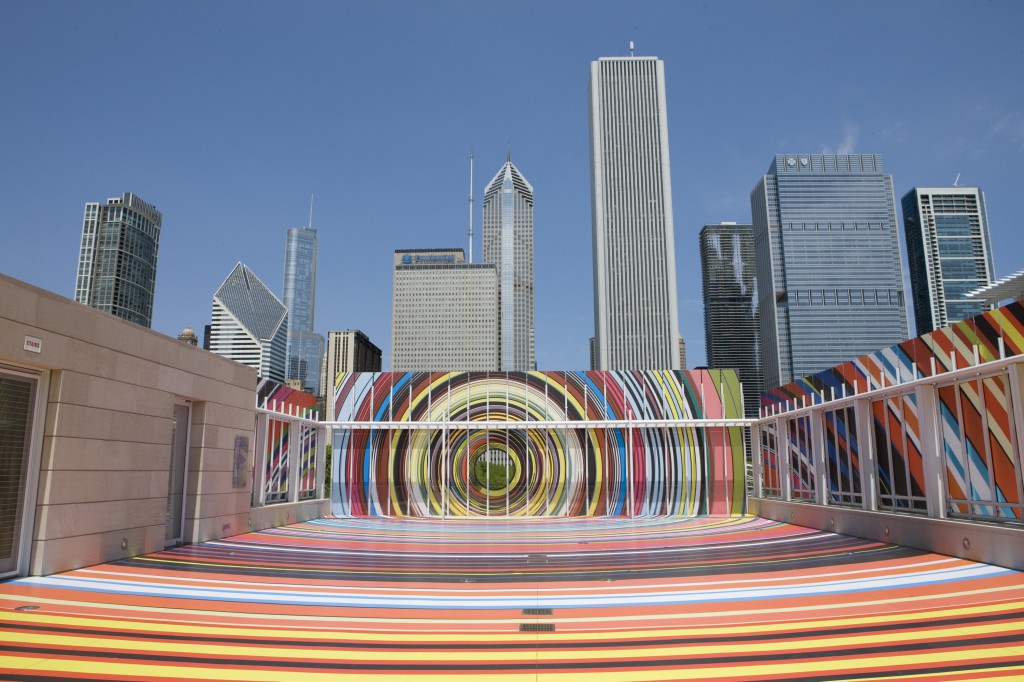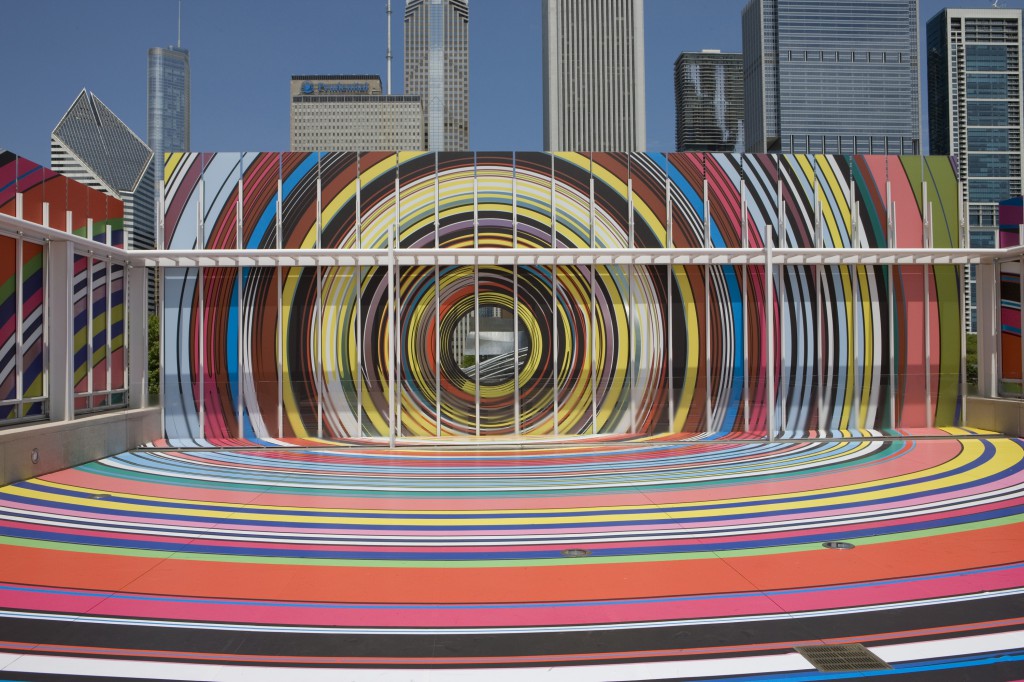PAE WHITE – RESTLESS RAINBOW by Nick Van Zanten
Pae White’s Restless Rainbow has taken over a terrace on the third floor of the Art Institute of Chicago’s new Modern Wing, with an outpouring of bright colors printed on opaque vinyl along the glass walls. Why this terrace is where it is, what’s so striking about it and why part of it hosts an expensive restaurant, is the view that it has of Lake Michigan and Millennium Park, and beyond it the dense center of Chicago. It’s a fantastic spot from which to look at the sculptures in the adjacent park, such as Anish Kapoor’s Cloud Gate or Frank Gehry’s band shell. White set out to break down the spatial dynamics of the terrace, closing it off to people inside of it and making it prominently visible to those looking up at it. Before, this terrace allowed visitors to see everything while remaining hidden from street level; now it is conspicuously visible from the ground and offers no view.
Restless Rainbow is an image, a myriad of colored concentric circles that look like an enormous, psychedelic vinyl record. In the accompanying text, White says that she had the idea for the installation while wondering what would happen if a rainbow were to fall from the sky. What if it became jumbled, and the misty colors of refracted light became the hard saturated colors of comic books, transparency became opacity? I assume the artist wishes us to draw a conceptual rather than aesthetic connection. Rainbow certainly changed a great deal in its descent; beside the obvious fact that the colors have no relationship to the spectrum of a rainbow, Restless Rainbow is by necessity static, concrete, and objective rather than fleeting, ethereal and personal to each viewer. The chaos of bright colors bouncing off one another have a great optical effect, closing off the space through their sheer brilliance (viewers can still see over the top of the installation, but that view is dull by comparison). From the inside the view is not only blocked but forgotten, sealed off by what’s on the walls, and the terrace becomes, in effect an interior room. All this play with the view made me think of how two-dimensional art traditionally works as a window. White, an artist who has done many images of air, has taken this opportunity to do the reverse. At the center of it all is an oculus through which one can still see out. Humorously, this view is neither central to the original architecture of the space nor to its surroundings – looking out it one sees the flank of the Gehry band shell and some nondescript mid-century office towers. The expansive view offered by the terrace has been focused into a single point that might also be the weakest.
White’s description of where she got the idea from strikes me as an allegory for the creation of any physical image based off of a mental image that is, like a rainbow, apparent only to the viewer and only fleetingly. This connection is driven home by the mysterious writing across a glass railing at the end of the terrace, facing out towards the street that cannot see it, which reads “i can never get it light.” If White really was trying to take an idea of a rainbow into the physical realm and make it into an art object she would have to take it out of the sky, to compromise and render it still and opaque. She couldn’t get it right and make it light or fleeting; it would be heavy, dark, confused, and restless.
Pae White likes light and air, and a rainbow seems an obvious subject for somehow who’s already covered smoke and reflections. Yet Restless Rainbow is neither light nor airy, despite the source material, which is what interests me so much about it. Maybe she felt that the terrace already had enough of that, and the only way to go was the other way. This is certainly what she did, backing away from her usual mode and drastically reworking the terrace in a way that we wouldn’t expect from her. Compare this rainbow to one of White’s enormous smoke tapestries: both take an image that confuses the basics of objecthood and create an art object out of it. But the smoke tapestries are images of smoke captured in a traditional way, and recognizable, and they were throughout the process, while Restless Rainbow is an image of a whole other sort. The rainbow in Restless Rainbow shows difference more than presence, between the source and the art derived from it, and between it and White’s usual process. Restless Rainbow is a commentary on the rest of her work, one that, like her other pieces, plays with what we think we can see. Fittingly, it frustrates our ability to see.
White certainly asserts herself over the terrace. Restless Rainbow causes you to forget the skyline and boxes the space in, making it an interior by virtue of its presence, while at the same time leaving the area itself completely open. While some might feel compelled to bemoan the loss of such a view, especially if your wedding is taking place on the terrace, it’s hardly unique – there’s a bridge right next to the terrace that has a better vista anyway. White’s new use of the terrace is as compelling as the view, and we shouldn’t feel that she failed to utilize it. Restless Rainbow blocks out almost all of it and manipulates the rest to its liking, turning the terrace inside out. What more could we ask when giving such a space over to an artist?







